
Looking for more?
On our Sortable Master Directory you can search by keywords, locations, or historical timeframes. Hover your mouse over the headlines to read the first few paragraphs (or a summary of the story) in a pop-up box.
... or ...
PORTLAND, MULTNOMAH COUNTY; 1960s:
P-town lost world’s biggest log cabin in 1964 fire
Audio version: Download MP3 or use controls below:
|

All of it went up in flames on what was surely the biggest and most spectacular single-building structure fire in Portland history and, until the 1992 burning of the blimp hangar in Tillamook, in Oregon history as well. The fateful nightOn August 17, 1964, the Forestry Building’s caretaker locked up for the night at around 5:30. Within 45 minutes, neighbors were noticing that something was wrong. Specifically, the place was on fire, and when the fire crews arrived at around 6:15 it was clear that nothing short of direct divine intervention was going to put it out. “There was never a hope of saving the building,” the Oregonian reported the next day. “Nothing was saved from the inside.” It turned out that the fire had been started by some bad vintage-1905 electrical wiring. Had it broken out an hour earlier, the caretaker might have seen it in time to raise the alarm and possibly save the building. But that’s not what happened. The fire rapidly grew to spectacular proportions, and people flocked to the scene from all over Portland. Grant Kelton was a boy at the time, living about four blocks from the building. “The flames were almost ten stories high. The fire illuminated the sky for miles, the neighborhood was an orange glow,” he wrote on his Website. “The windows on the entire south side of the Montgomery Park Building were blown out. The heat was so intense that the windows were popping out. Glass was falling down to the street below. Ashes the sizes of large snowflakes fell to the ground within a mile of the structure. It was surreal, an amazing sight.” Some of the spectators, the Oregonian reported, were in tears. Afterward, the city pulled itself together as best it could. Citizens and civic leaders got together with timber-industry leaders to create the Western Forestry Institute to fill the void. The new institute soon had a new building, roughly the same size as the old one, in Washington Park; generations of northwest Oregon schoolchildren remember it from field trips to “the Zoo, OMSI and Forestry Center,” before OMSI (the Oregon Museum of Science and Industry) moved to its present location. So the mission of the Forestry Building lives on. But as for the building itself, it was an artifact of a time that is gone and is not coming back — the great heyday of old-growth logging in Oregon.
|
©2008-2023 by Finn J.D. John. Copyright assertion does not apply to assets that are in the public domain or are used by permission.





